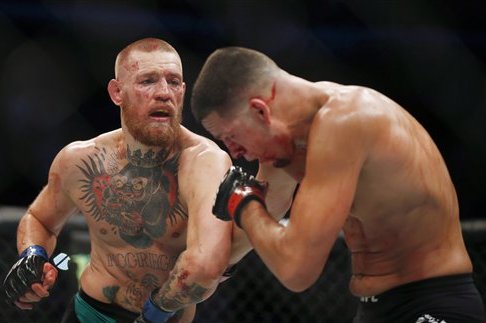UFC 202 is in the books, and it was a barnburner of a card from top to bottom.
On the undercard, Lorenz Larkin announced himself as a legitimate top-10 welterweight by destroying the legs of Neil Magny. Cody Garbrandt continued his momentum by destroying veteran gatekeeper Takeya Mizugaki, setting up a title fight with Dominick Cruz that promises both a great build and fireworks in the cage.
The real action took place on the main card. The first two bouts, Tim Means vs. Sabah Homasi and Mike Perry vs. Hyun Gyu Lim, both delivered devastating knockouts in low-stakes outings. The top three fights, however, were all of the utmost importance in their respective divisions.

In the co-main event, Anthony Johnson knocked out Glover Teixeira in just 13 seconds to punch his ticket as the likely next top contender at 205 pounds. This was a short fight, though, and there's not much to break down in such a short scrap.
The same can't be said for Donald Cerrone's performance against Rick Story and, of course, the fight-of-the-year candidate in the main event as Conor McGregor and Nate Diaz went the distance in their rematch. In this piece, we'll take a deeper look at how McGregor managed to even the score against Diaz and what has led to Cerrone's resurgence in his three fights at welterweight.
Donald Cerrone vs. Rick Story
In terms of speed and other physical gifts, the 33-year-old Donald Cerrone may have lost a step compared to his younger self of 2011 or 2012. If that's the case, he has more than made up for it with veteran savvy.
That couldn't necessarily be said of Cerrone during the eight-fight winning streak that led him to a title shot against Rafael Dos Anjos.
A defined outside striker, albeit one with a sharp wrestling and grappling game, there was no real mystery about what Cerrone wanted to do: stand at long distance, flash hands and follow with vicious kicks at all three levels. Low kicks fed into high kicks and vice versa in a veritable wood chipper of rangy violence.
Conversely, however, the weakness of that style was always clear: pressure.
Cerrone struggled with every fighter who could walk him down and force him to fight off of his back foot, from Nate Diaz to Dos Anjos. For Cerrone's opponents, success was never a matter of coming up with a new game plan, but whether they had the durability, cardio and technical acumen to stick with a pressuring approach.
In Cerrone's last three fights, that has changed drastically. Perhaps recognizing that he's getting older, or benefiting from the coaching of Jackson-Wink's Brandon Gibson, a rising star within the MMA training world, Cerrone has made a series of small tweaks that have helped to solve some of his past issues.
At the root of these changes is a variable approach to dealing with his opponent's forward movement. Against Alex Oliveira, Cerrone planted his feet, ducked under and completed a takedown; against Patrick Cote, Cerrone used both takedowns and an increased willingness to counter with punches in the pocket.
Against Story, Cerrone used takedowns, punch counters and a gorgeous counter knee in combination.

Taken together, they represent a comprehensive response to any kind of pressure. When Story tried to wing punches as he came forward, Cerrone either ducked under for the takedown or pivoted and threw a right hand over the top of Story's left. When Story tried to take him down, Cerrone timed a counter knee as Story ducked under.
Tighter footwork is the key to all of that. In the past, Cerrone needed a great deal of space to operate; while he cut angles regularly, particularly as he went from punches to kicks, they were big, sweeping movements in open space. He didn't have a great command of pivots or short, technical, boxing-style footwork.
Now he does. The pivot is what enables Cerrone to counterpunch safely, without exposing himself to a straightforward brawl, and it gives him a better angle from which to hit his takedowns.
There's nothing fancy about these changes, but they've made an enormous difference for a fighter who was thought to be a known quantity.
Nate Diaz vs. Conor McGregor
"He's a hell of a competitor. He brought out the best of me," said McGregor of his foe during his post-fight interview with Joe Rogan, and there's no better way of summing up the fight.
Diaz and McGregor went back and forth for all five rounds. McGregor took the first two with a sharp, disciplined approach, but Diaz roared back to land big shots on the tiring Irishman with a borderline 10-8 in the third.
For a couple of minutes, McGregor looked like he was on the edge of being finished as Diaz landed combination after combination.
But then McGregor adjusted. He stuck and moved behind a stiff jab, cut angles to land the left hand and kept cracking away with low kicks. He adjusted his rhythm and quit throwing everything so hard in order to preserve his gas tank. He scored points rather than looking for the knockout, and it won him the round. While Diaz won the close fifth round, McGregor had done enough to win it on points.
Diaz is a god-awful stylistic matchup for McGregor, and to beat him the Dublin native couldn't simply go out there and try to knock his block off.
Diaz is too tough for landing a fight-ending shot to be a viable strategy, he's too well conditioned for McGregor to work at his usual quick pace and as a tall southpaw, he could dominate long range—McGregor's preferred stomping grounds—with his razor-sharp jab-cross, slapping right hook and subtle footwork.
Moreover, McGregor's best weapons aren't as effective against southpaws.
The punch he used to knock out Jose Aldo, bust up Chad Mendes, destroy Dennis Siver and finish Ivan Buchinger back in Cage Warriors, for example, is an inside-angle left hand.
McGregor allows his orthodox opponent to step to the outside of his lead foot and then throws the left hand as he pivots and allows his left leg to swing into position behind him. It's a devastating punch because it lands across the plane of the opponent's body, which means the legs can't bend to absorb the force of the shot.
That angle simply isn't there in a southpaw-southpaw matchup, because there's no comparable battle for outside foot position.
That's just one example of the difficulty Diaz poses for McGregor. To beat Diaz, McGregor would have to utilize techniques he normally doesn't. More importantly, McGregor would need to fight strategically, putting together a game plan that allowed him to score points and land meaningful shots without expending the entirety of his gas tank in a mad hunt for the finish.
Because of his streak of knockouts, McGregor had never really been forced to think more than a few exchanges ahead. That doesn't mean he wasn't capable of it, just that prior to facing Diaz, it hadn't been necessary. Against Max Holloway in August 2013, McGregor tore his ACL and had to readjust to a wrestling and top-control plan, but that probably wasn't a pre-set strategy.
Against Diaz, McGregor would have to carefully plan for everything ahead of time and then readjust during the fight itself. He did both at UFC 202.

The most obvious addition to McGregor's game was a steady diet of round kicks to the legs. Despite their proven effectiveness against the Diaz brothers, meat-and-potatoes low kicks hadn't been a significant part of his arsenal in any of his previous fights.
Low kicks are a product of muay thai or the Dutch style of kickboxing, which McGregor made a point to eschew in his post-fight interview (warning: NSFW language) after UFC 178:
I just find that a lot of mixed martial artists get into a rut, coming out with that Thai boxing flat-footed style. Against a guy like me that’s in and out and light on it’s feet, the angles are different.
McGregor obviously got over that for the purposes of the Diaz rematch. Those kicks beat up Diaz's lead leg and took some of the spring out of his step for the later rounds and scored necessary points in a fight that would go the judges' scorecards.
More importantly, the kicks allowed McGregor to control the distance and land meaningful strikes at long range. In the first fight, Diaz dominated that distance with his jab, cross and slapping right hook, which forced McGregor to explode forward to land strikes. That cost him valuable energy and led directly to his submission in the second round.
This time, McGregor was able to much more precisely control the distance. This allowed him to fight more efficiently and to conserve energy. Moreover, those kicks cut off Diaz's escape angles and helped McGregor force him back to the fence. This too helped McGregor conserve energy: He didn't have to move as much in order to get into a range where he could land powerful shots.
The combination of the low kicks and heavy left hand won the first two rounds for McGregor, but Diaz won the third by a substantial margin. It looked like McGregor was done.

Somehow, McGregor summoned the will to fight the best round of his career. He adjusted on the fly, circling through the space of the cage and firing off a sharp, consistent jab. He still threw power shots, but mixed up his rhythm and force; instead of throwing everything hard, he went soft, soft, and then put all his weight behind a big left hand. He used the clinch to rest and reset his distance when he needed to.
After looking completely out of gas, per FightMetric McGregor managed to throw 76 strikes in the fourth round. That was the most of any frame in the fight, even more than the breakneck second round.
A McGregor who stuck and moved while picking his spots to sit down on counters or land a smooth combination isn't the usual McGregor, but it was who McGregor needed to be at UFC 202 to defeat Diaz.
There were many other things we could discuss in this fight-of-the-year contender, but the addition of the low kick and jabs gave McGregor more options to work with. He stuck to a disciplined game plan early and adjusted late. Intelligent, strategic fighting got him over the hump of an exceptionally difficult stylistic matchup and won him a close victory.
Who knows what Diaz and McGregor might bring out of each other if they meet a third time?
Patrick Wyman is the Senior MMA Analyst for Bleacher Report and the co-host of the Heavy Hands Podcast, your source for the finer points of face-punching. He can be found on Twitter and Facebook.
























